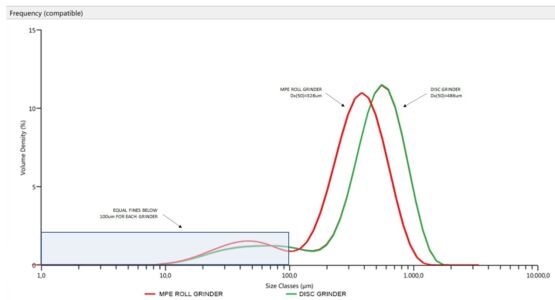Grinding for Coffee Capsules
Do you know the difference between disc grinders vs. roller grinders and how it affects your capsule performance?
Depending on the quantities you will be producing, there are three main factors to consider:
- Grind Profile Differences
- Density Control
- Consistency
Grind Profile Differences
- Disc Grinders offer only one adjustment, which is the distance between the discs. The speed or relative speed of the discs has little effect on particle size distribution. Roller grinders have independent gap adjustment and speed differential control on all grinding sections (typically 3 sets of grinding rolls in the case of espresso grinding); therefore, users can manipulate the particle distribution profile and average grind size in different ways. When users desire a narrow particle distribution profile with minimal fines, such as the case with Nespresso compatible capsules, roll grinders will deliver the grind profile with a finer average size and still with less dust below 100 microns than disc grinders.
- Additionally, roller grinders are easier to keep cool while running and also eliminate most of the particle-on-particle friction during grinding. This leads to less heat introduced into the coffee by roll grinders.
- Outcome
- Roller grinders allow for a sharper and more uniform particle distribution profile, which allows for higher solids extraction yields using the same amount of coffee and with more consistent brew times.
- With roller grinders, operators have control over the percentage of fines below 100um, so brew times can be adjusted to the desired time.
- Due to the smaller average grind size and more control over the fines (particles below 100um), NC capsules produced with proper roll grinders also have more crema when brewed.
Density Control Differences
- Disc Grinder
- Zero density control
- Roller Grinders
- 0-45% increase in free fall density using the MPE Vortex Densifier System. This allows users to normalize bulk density volumes. Dark roasts do not need to be compressed into the capsules to achieve the gram weight; therefore, flow becomes easier.
- Densification (compaction), if done properly, can further reduce fines less than 100um by ~1% by tucking fines into the crevices of larger particles. This further aids in brewer water flow.
- Result
- Density control gives users the ability to place more coffee in a capsule at a consistent fill height. If users wish to insert 6+ grams per NC capsule enabling a stronger espresso brew, it is possible using density control on light and dark roasts.
- Users can adjust the optimal coffee fill height for various coffee roast degrees, various capsule internal volumes and desired gram weights.
Consistency Differences
- Roller Grinder
- Consistent start to finish and the fines can be controlled using roll gaps.
- Brew Times: Low variance/consistent
- Disc Grinders
- Heats up after 20-25 minutes and grind profiles changes, more fines are produced, and operators need to adjust.
- Brew times: High variance
MPE Single Serve Systems and Grinders
Video of Coffee Capsule Systems
MPE Systems Group designs coffee capsule systems around the world.









